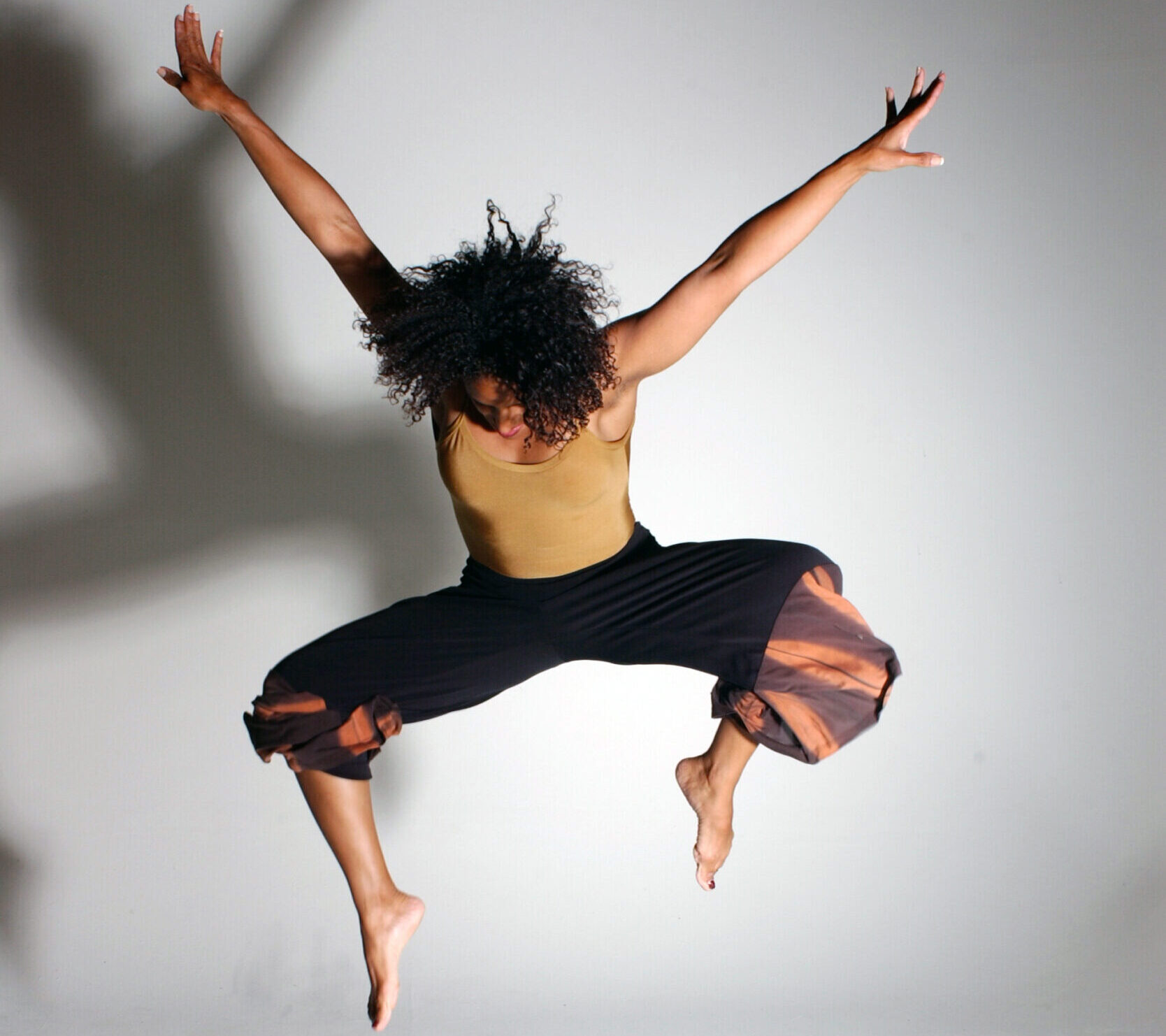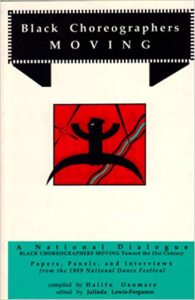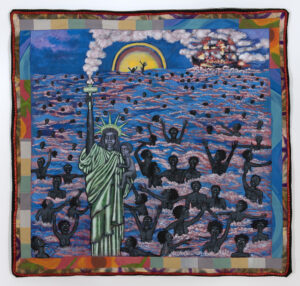
laura elaine ellis. Photo by Andy Mogg.
[ID: Black female dancer with curly black hair, jumping high in the air with arms extended up and out, knees bent. Wearing gold tank top, black flared pants with gold and black print on the bottom of the pants, and maroon painted toe nails, against a beige background.]
Deafening applause and uproarious bravas, the stands in Theater Artaud (now Z Space) were packed and rattling from all the feet stomping. Community came out for the Black Choreographers Moving Toward the 21st Century (BCM), standing ovations after every performance. Every show sold out that weekend —it was electric!
And then it was over! 1995 would be the last year of BCM.
I hold the memory of BCM dear, not just because of the excitement and verve of community rallying around the festival that particular year, cheering on the eclectic array of works performed, and not just because I was one of the emerging choreographers who debuted on that stage, but because it was a time we thought of as a singular moment—the one time that BCM programmed only Bay Area choreographers for this renowned festival. I remember the synergy that was conjured, as well as what was catalyzed in that weekend of BCM. It was a pivotal happening that would reveal the need for all of us Black choreographers to create a coalition, keeping us connected and supporting each other going forward.

“Looking back, one run-out performance project was a turning point in my career: Dance Black America (1983). This was the first time that I had been part of a Black dance program that convened dance with humanities in a thorough way, and this fascinated me. It planted an internal seed that would eventually allow me to start my own comprehensive black dance initiative by the end of the decade.”
(Learn more about Black Dance America.)
BCM was Dr. Osumare’s Black dance initiative, debuting in 1989. In her memoir, she also wrote about her vision for this initiative:
“I wanted BCM to focus on dancemakers and their individual artistic statements rather than on the conundrum of “black dance” itself. One decade away from the new millennium, I felt it was time to make a national statement about the state of contemporary black choreographers…”
After those powerful last performances of BCM, many of us participating choreographers felt compelled to keep Dr. Osumare’s vision moving forward. So, in 1995, a group of us, including Blanche Brown, Joanna Haigood, Robert Moses, Kevin Ware, Aisha Jenkins, and me, as well as Bay Area arts administrators Jennifer Ross and Angela Johnson, held a series of round tables discussing next steps—there was a continuum at work, a Black dance legacy, defining a need for us to shape our own future.
We formed the African & African American Performing Arts Coalition (AAAPAC). In 1996, I incorporated AAAPAC as a fiscally sponsored non-profit and began presenting several concerts that year and through 2003. In 2002, I was artistic director and collaborator on a cornerstone project awarded the Creative Work Fund and produced by ODC Theater in response to Faith Ringgold’s story quilt We Came to America. The work featured four choreographers: Moses, Ellis, Jenkins, and Robert Henry Johnson (1968 – 2022); a host of dynamic performers including Marc Bamuthi Joseph, Silfredo La O Vigo, and Nora Chipaumire; and an 11-piece music ensemble conducted by musician/composer Wayne Wallace. The Smithsonian partnered with us, and we were able to display Ringgold’s iconic quilt in the lobby of ODC Theater. We rode the momentum of that successful project, and in 2003, I began to plan, with Kendra Kimbrough Barnes, the Black Choreographers Festival: Here & Now (BCF).

Image depicts the Statue of Liberty as a Black woman holding a small child, surrounded by water filled with escaped formerly enslaved people flailing and screaming while a slave ship burns in the background. Flame on torch has been extinguished. Big sun on the horizon.]
We saw Dr. Osumare’s BCM as a model for a Black dance festival that we could use as a framework for our vision. With her blessing and the support of Rob Baillis, director of ODC Theater at that time, Kendra and I would ambitiously do what had not been done before: create a consortium model of presenting and host a Black dance festival on both sides of the bridge, Eastbay and SF.
In 2005, Black Choreographers Festival: Here & Now (BCF) had its debut, curated with an intentional blend of the past and present, including iconic works of choreographers that were part of the BCM programming: Donald McKayle (1930–2018), Haigood, and RH Johnson, as well as emerging choreographers Latanya d. Tigner, Malia Conner, and Rashad Pridgen (1978–2024). Multi-faceted artist Bamuthi also MC’d and performed.
(Read Dance Magazine’s review of BCF’s opening night performance at SF’s Theater Artaud.)
Here we are, 2025. When asked to reflect on what this 20th anniversary means to her, Kendra shared, “This anniversary is not just a celebration of the past; it is a call to action for the future. There is still much to be explored, celebrated, and shared. The next 20 years will be about continuing to uplift the next generation, expanding our reach, and pushing the boundaries of what is possible in the intersection of art, culture, and activism.”
Kendra and I have witnessed so many of the choreographers who performed in BCM and BCF go on to have a national and international presence and make significant contributions to the dance world at large. We will ride the continuum of this Black dance legacy through the 21st century, seeing what can be transformed, broadened, and handed up in the years to come.
This article appears in the Winter 2025 issue of In Dance.


